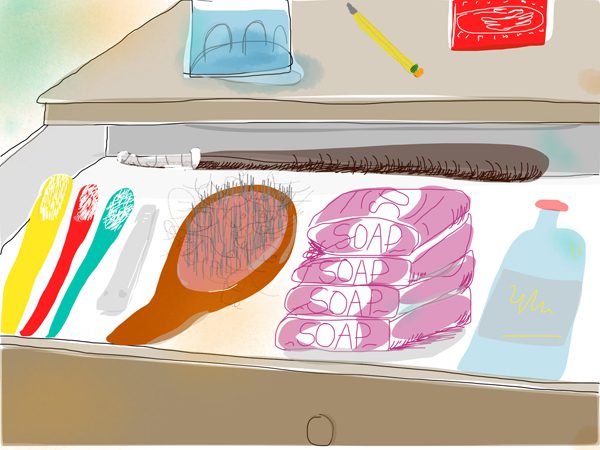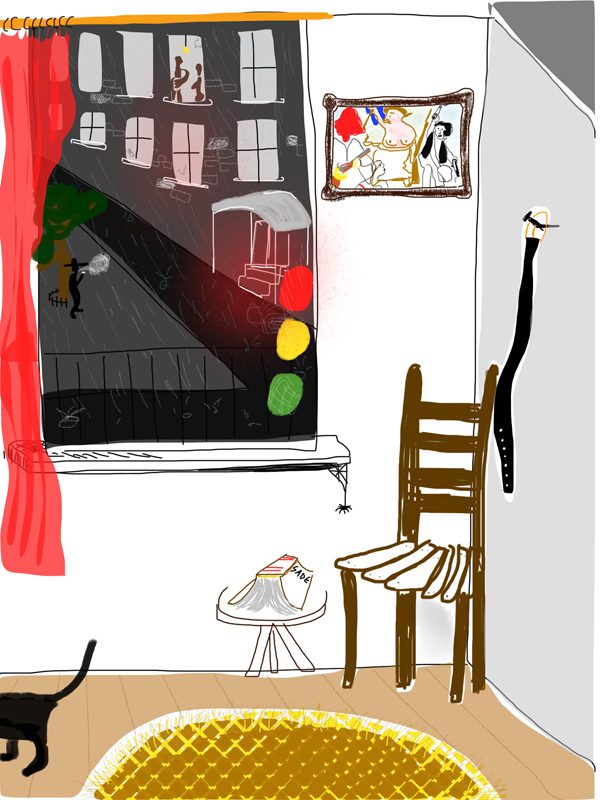There’s evidence that D.H. Lawrence enjoyed an erotic power exchange relationship with his wife, that James Joyce was into scat (among other things), and that Oscar Wilde—well, most of us know what Oscar Wilde liked. These literary geniuses explored radical sexual agency and desire in their work and in their relationships, but little beyond rumors and personal letters exist to tell us what they themselves thought of their turn-ons and the ways in which those dovetailed with their writing. Even if space for such a discourse and community had existed back then, Lawrence, Joyce and Wilde couldn’t freely discuss their sexuality. As it was, they faced censorship and generated scandal wherever they went, and of course Wilde went to prison for his sexual behavior.
Although our world is still intolerant of sexual difference, I want to believe we’re at a point where people can speak openly about the consensual ways we express our erotic selves. And I’m interested in the connections between those private expressions and the larger, more public work we do in the world. This series is meant as a forging of community; a validation of that which gets called sexual deviance; and a proud celebration of the complex, fascinating ways that humans experience desire.
In this ongoing series of short personal essays, writers in all genres—novelists, poets, journalists, and more—explore the intersection between our literary lives and practices and our BDSM and fetishistic lives and practices. In other words, these essays aren’t about writing about non-normative sex: rather, it’s a series about how looking at the world through the lens of an alternative sexual orientation influences the modes and strategies with which one approaches one’s creative work.
If you have questions or comments, or if you’re a writer who would like to contribute, please contact me at kinkwriting@gmail.com.
–Arielle Greenberg, Series Editor
***
In a Room: A Kink Is Being Historicized
I write fiction, generally short stories, and I often find that when I sit down to write, the first thing on my mind is atmosphere and ambiance. If a scene takes place indoors, in a room—and for me it often does—I am considering things that will likely not make their way into the text but still influence the feel of the story. For example, if music were playing, what would it be? If I imagine Delta blues, then I’m in a very different story than a room where I might hear Erik Satie, Coil, or the new Kendrick Lamar. This imagined music, though not a part of the story, helps shape a world, one with a background and a history.
The other thing I do when I sit down to write is read. When I claim to be writing, more often I’m reading. If I’m working on short stories, I’m probably reading short stories—trying to parse out difference by working through similarities. I ask questions of the stories I read. I seek out the feel of a piece, the mood it strikes. And then I shape it in my mind to make it my own. Often I begin to write with something that doesn’t fully belong to me. Is that ethical? I’m still trying to figure that out.
The way I think about my writing is similar to the way I think about my kink—both have to do with history and the ethics around appropriation.
I made this connection a few years back, when I toured the San Francisco Armory. Many people in the kink community know that the former armory and arsenal was bought by Kink.com in 2006 and turned into a studio for the company’s various BDSM websites and ventures. It’s also one of the sites of the San Francisco General Strike in 1934, more commonly known as “Bloody Thursday.” So while on the tour, I was thinking through the city’s history of economic oppression, organized resistance, labor unions. It wasn’t until after the tour, when guests were encouraged to head over to the Armory Club across the street for drinks, that I began to reflect on some of the individual spaces I saw in the building.
The bar is an upscale place, and you might not know it’s affiliated with the website were it not for its name and the TV screens with rotating images of the empty sets from the armory itself. Devoid of people fucking and hitting each other, the sets have a surreal calm, appearing as empty simulacra. If I’d stayed long enough, I might have seen someone wander into the shot to start cleaning.
Mainly these were dungeon-esque spaces on the screens, and I was mostly indifferent to them. One of the spaces that piqued my interest, though, was the loft apartment set, complete with a fake bathroom, an open concept kitchen, Post-it notes, and a plate with glued-down, half-eaten, plastic hors d’oeuvres.
I am turned on by place. More specifically, I am turned on by the private sphere. I’m not necessarily into, say, a sexual partner doing the dishes naked, or being disciplined for not making the bed. Rather, it is the domestic space itself as a frame for these acts: the eroticized movement through the familiar, the slightly torqued interaction with everyday objects. The bathroom, where the hairbrush sits between extra toothbrushes and packages of soap in the drawer with the loose pull, an implement for beating someone hidden in plain sight. The kitchen with its magnetic hook on the refrigerator, the one that slides down a few inches from the weight of the leash, even though there’s no dog. There could be a dog, though. What are arousing to me are those possibilities, those alternatives. Which is also why I read. I read searching for the ambiance and atmosphere of sexuality and deviance.
My fetish for the domestic space isn’t unique. But what usually gets left out of the depiction of kink in literature, and what happens to interest me, are the ways in which cultural and historical inequalities—on a social rather than individual level—inform our sexualities. The political, economic, racial, sexual, transnational, psychic, timely, timeless, highly situated backgrounds can get lost as we dig and stumble, trying to find what resonates with our sexual wiring.
While I was sitting in the bar across the street from the Armory, the images of each set on maybe a thirty-second rotation, I realized that I still have some anxiety about my own kinks. As a mostly straight, white, cis man, I often question the moments when my desires and interests converge. I sat there musing on whether my research, and the reading I’ve done, have shifted some of my desires, or if the inverse might be true. For instance, did reading Pauline Réage’s Story of O turn me on because of the depictions of delegating control over someone in a kind of hierarchy, or was that already floating around somewhere in my head? Or was the first thing that sparked these desires in me Amber Musser’s Sensational Flesh: Race, Power, and Masochism, and her close reading of Nora’s character, the “mulatto maid” who dresses and whips O for Sir Stephen?
As the night progressed, the Armory Club began to fill up with people. I was seated at the bar; there was the surge of skin and bodies around me. The empty apartment was on the screen when it came to me: the stage set felt too chic, too contemporary, too sterile in its spare aesthetic, despite the notes and plates. It represented affluence without historical context, and then I had a further realization: class has become a factor in my attractions. This fact should’ve been obvious. How many times have I returned to Apollinaire’s Eleven Thousand Rods or Delany’s Hogg, two novels playing at the intersection of class and sexuality despite characters who land at opposite ends of the spectrum?
But playing with class in a vacuum isn’t enough for me. When I start a kink scene with a partner, the process mirrors my writing process: I begin to play with something that doesn’t belong to me. This can involve sex, gender, race, nationality, class—all of these relationships to power are built into the history of my kinks, of kink as a whole. The work I do as writer, exploring and researching these social issues, helps me notice when they appear in my own desires. And I’m grateful for noticing, because the alternative is a brand of ignorance—or, worse, outright denial. In my life, just as in my writing, the things left out—uncommunicated, unexamined—become a critical part of the story.
The woman sitting two stools over was on the tour with me. She was attractive and quiet, sitting alone, and before the tour began I thought with near certainty that she was the guide, perhaps also an actress in the films. It turned out that she was just like me: curious, interested. When the seat between us opened up I began to talk to her—she had an Eastern European accent, maybe Russian or Romanian, and that, paired with a few drinks, was enough to spark some kind of desire—a flash of something I wasn’t completely comfortable with. In my head, she fit within a specific script, a generalized stereotype of nation and class that for me, in that moment, called up a fetishized version of domestic abuse: a small, cramped apartment, bare light bulb, belt hanging from a nail in the wall, half-empty bottle of vodka. These are details that, if I were writing the scene, the room, trying to stay conscious of the tightrope between specificity and cliché, I would be hesitant to even include. But this was a person, not a fantasy, and there was no scene. We just talked—pleasantries, ordinary conversation. She was just moving to the city, so we chatted about different neighborhoods.
The point is, it’s necessary to question the ethics of my initial reaction, and the ethics of fantasy. In part because she had no say in my internal thought process. In part because of the stereotyping involved in fantasy. But questioning a fantasy shouldn’t necessarily imply dismissal of it.
Still later that night, the screen showed the set of the Upper Floor, a kind of contemporary take on a Paris salon: button-tufted furniture, burgundy and black damask, gilt frames on the sofas and paintings. On the Upper Floor, people—non-actors—from the kink community are invited to participate. The appeal in it, for me, is in the merging of the individual and the social, the private and public. One of the goals of historic salon culture, after all, was to break down these distinctions. But it’s probably safe to say that a majority of people, even within the kink scene, have not read literature about those original salons: Proust, or Bataille, or maybe even Sade. Such parties get removed from their historical context. Many of us are not actively thinking through the French Revolution and bourgeois conceptions of labor and property as we consume Kink.com’s web content.
I’ve been asked before in writing workshops, both as a participant and as an instructor, about the danger of sexualizing historical and contemporary inequality. The instance that stands out most clearly to me concerned one of my stories that focused on a black character who identified as something between a sub and a slave in a consensual BDSM relationship. The story also focused heavily on blues music and its history. We could have had an important discussion about appropriation—about whether or not it’s okay for white people to write characters of color. Instead, we had an equally important and political discussion, about whether or not the very concept of the story—that a black character might consciously connect their own racial and historical discrimination with their sexuality—is offensive.
The notion that sex may be racialized and race may be sexualized still feels radical in our culture, but it gets explored in myriad complex ways in the kink community. Mollena Williams, a brilliant thinker on the topics of race and race play, describes herself as “[…] an American descendant of chattel slaves who is ALSO a kinky person who gets off on the idea of being consensually owned by another person,” arguing that, “it would be futile to be involved in kink and try to deny the history that it echoes, however distantly.”
It’s crucial for me to think through such issues. Whether it’s race, class, gender, or any other number/combination of social inequalities, I consider these things, and I write about these things. Sometimes I fantasize about them. Sometimes I act them out in play. The theorist Lynda Hart, in her book Between the Body and the Flesh, writes:
All our sexualities are constructed in a classist, racist, heterosexist, and gendered culture, and suppressing or repressing these fantasy scenarios is not going to accomplish changing that social reality. […] I do think that being conscious about these issues as they appear in our desires is important to discuss, theorize, and suspect.
So here I am, and I am suspicious. When I sit down to write and begin to imagine a room, if I can see out a window, hear the thrum and drawl of heavy rain, the red glow of traffic lights onto the wet street, I’m imagining real violence—in the moment or further back in history, echoing through the city’s vibrations. Maybe it’s because I’m trying to prove something: that my own pleasure comes at a cost. Or maybe it helps me to get off. More likely it’s both. And when I sit down to read, to search out the writers who are doing new things with sex and deviance—writers like Octavia Butler, Samuel Delany, Pat Califia—I wonder whether I’ve come to them as a writer or someone invested in kink. At a certain point I can’t tell the difference.
***
Rumpus original logo and art by Liam Golden.





